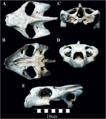Chelonoidis niger donfaustoi facts for kids
Quick facts for kids Chelonoidis niger donfaustoi |
|
|---|---|
 |
|
| Santa Cruz, Galápagos. 12 August 2014 | |
| Conservation status | |
| Scientific classification |
|
| Kingdom: | Animalia |
| Phylum: | Chordata |
| Class: | Reptilia |
| Order: | Testudines |
| Suborder: | Cryptodira |
| Family: | Testudinidae |
| Genus: | Chelonoidis |
| Species: | |
| Subspecies: |
C. n. donfaustoi
|
| Trinomial name | |
| Chelonoidis niger donfaustoi Poulakakis, Edwards & Caccone, 2015
|
|
 |
|
| Range of C. donfaustoi on Santa Cruz Island (inset: Galápagos Islands) | |
The Chelonoidis niger donfaustoi, also known as the eastern Santa Cruz tortoise, is a special type of Galápagos tortoise. It lives on Santa Cruz Island in the amazing Galápagos archipelago.
Before 2015, scientists thought this tortoise was part of another group called Chelonoidis porteri. But new discoveries showed it was unique!
Contents
Meet the Eastern Santa Cruz Tortoise
This tortoise is a fascinating part of the Galápagos Islands' wildlife. It's one of many giant tortoise types found there. These tortoises are famous for their long lives and huge size.
Tortoise Families on Santa Cruz Island
Santa Cruz Island is home to several groups of tortoises. Scientists studied their mitochondrial DNA to learn about their family trees. They found three different groups living in separate areas on the island.
These groups are in places like Cerro Monturra (northwest), Cerro Fatal (east), and La Reserva (southwest). Even though they live on the same island, these tortoise families are actually more closely related to tortoises from other islands. This means Santa Cruz Island was settled by tortoises from three different places over time.
Tortoises are great travelers! They can float in the ocean with their heads up. They can also survive for up to six months without food or water. This helps them spread to new islands.
How Scientists Classified This Tortoise
In 2015, Chelonoidis niger donfaustoi was officially named a new subspecies. This happened after scientists looked closely at its genes and how it looked. They found it was different enough to be its own group.
This eastern Santa Cruz tortoise is like a close cousin to the C. n. chathamensis tortoise from San Cristóbal Island. They are part of a larger family that includes tortoises from Española and Pinta islands too.
Scientists found unique genetic markers in C. n. donfaustoi. These markers helped them tell it apart from other tortoises. For example, it has special nucleotides that are different from C. porteri (on the same island) and C. n. chathamensis.
Because of this new classification, the C. porteri tortoise now only lives in the western and southwestern parts of Santa Cruz Island. The C. n. donfaustoi lives only in the eastern part. There are about 250 of these special tortoises left.
The scientific name donfaustoi was chosen to honor Fausto Llerena Sánchez. He worked for 43 years to protect giant tortoises in the Galápagos National Park. He was known as “Don Fausto” and took care of many endangered tortoises.
This was a big discovery! C. n. donfaustoi is the 15th known tortoise subspecies found on the islands. Four of these subspecies are now extinct. Finding a new tortoise subspecies was the first time in over 100 years!
What Does It Look Like?
The eastern Santa Cruz tortoise looks similar to other Galápagos tortoises. However, scientists can tell it apart by its shell size and shape. Some other Galápagos tortoises are bigger than C. n. donfaustoi. They also have a higher opening at the front of their shell.
Images for kids
See also
 In Spanish: Tortuga gigante de Santa Cruz Oriental para niños
In Spanish: Tortuga gigante de Santa Cruz Oriental para niños






